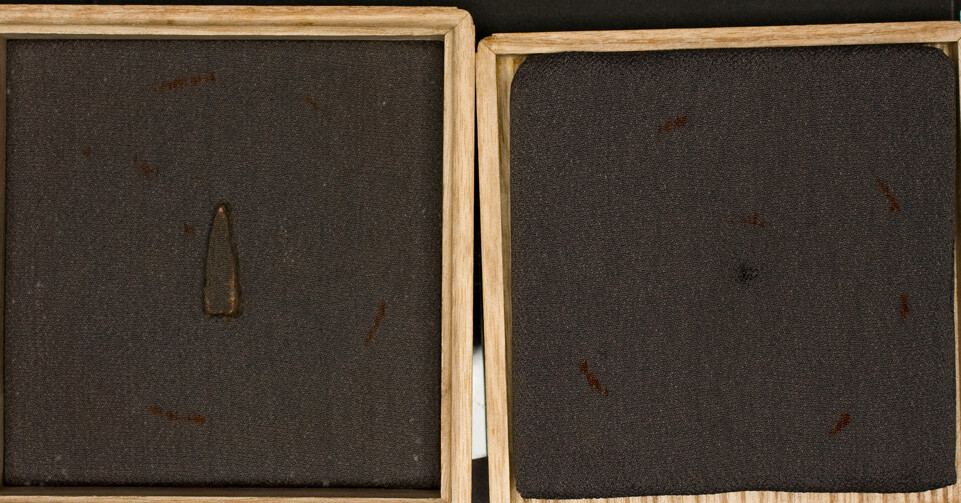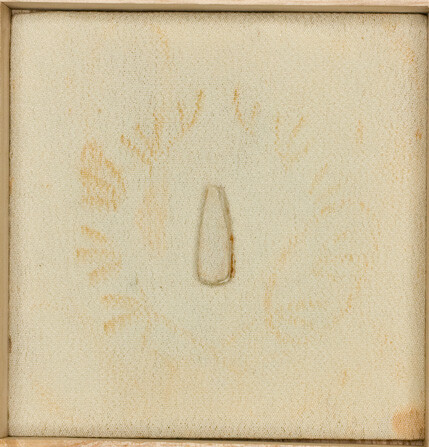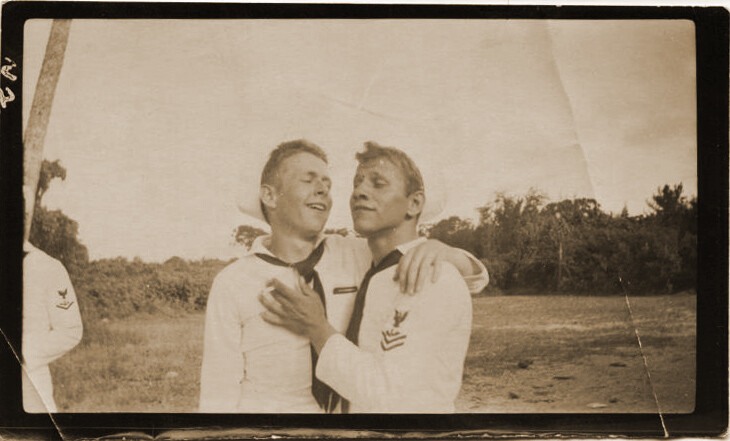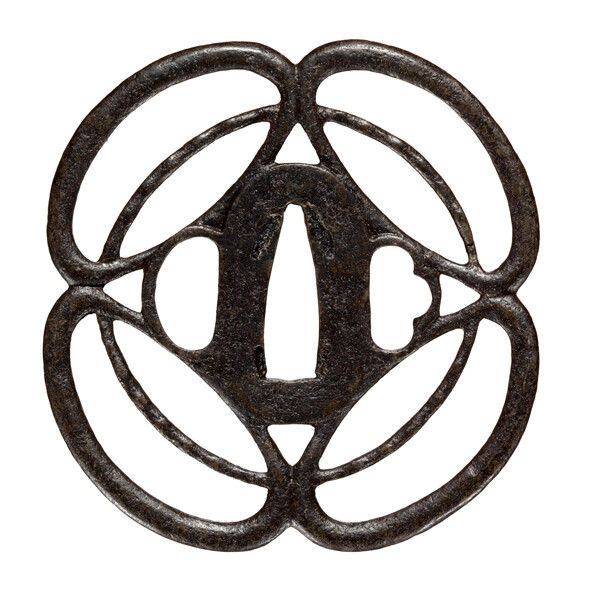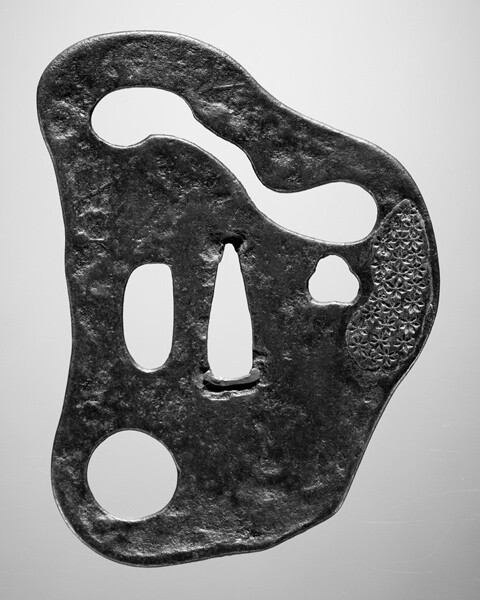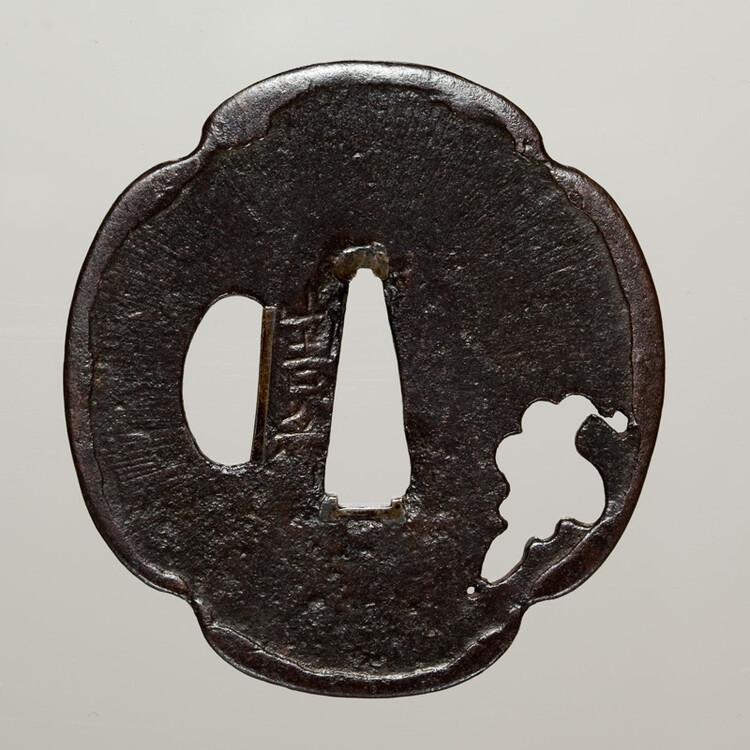-
Posts
835 -
Joined
-
Last visited
-
Days Won
7
Content Type
Profiles
Forums
Events
Store
Downloads
Gallery
Everything posted by rkg
-
What's on the other side? rkg (Richard George)
-
Curtis, you mean the mokume by Myochin Bob, or the other one? Best, rkg (Richard George)
-
Hey guys, While waiting for some pieces to arrive to image, I found myself with some spare time, so I took a shot at making up some tsuba box liners. I had earlier acquired some kimono silk off of fleabay (story about washing the stuff deleted), and since I figured I'd probably mess up I used some of what I thought was the least attractive material for the first two. I also experimented with several methods of wrapping the base, base material, etc. Under all of these I used a pec-pad as padding separated from the silk by a piece of thin Japanese paper. Here's the results: http://www.rkgphotos.com/recent_stuff/t ... _boxes.jpg http://www.rkgphotos.com/recent_stuff/t ... nd_try.jpg I also attached the nakago pegs using cord. I used this unwaxed linen cord you use in bookbinding on the first two - big mistake, it wasn't "stiff" enough, so the pegs would move around a lot - I ended up having to "pin" them from the back with thin bamboo pegs. I put the second two together with a heavy waxed cord used in leatherwork. Tolerable, but they still weren't perfectly rigid. For the base I tried both basswood and thin plywood - I found the the thin basswood bowed pretty badly when you coated it (I ended up using some archival/everything free varnish I use for coating my finished canvas prints), so I had to hold it flat until it dried - on the other hand the basswood was easier to cut with the limited tools I had/was willing to drag indoors from the shop. I also played with using both an acid free pva and quick grip (its acid free) as adhesives - I found that using the acid free pva watered down to adhere the paper to the back of the base, and quick grip for everything else seemed to be the ticket for me. I also found that folding the material with the corners cut out was the easiest/generated the cleanest looking result. anyway, some random pics of the construction of the first couple of boxes are here if you're interested in more details: http://www.rkgphotos.com/recent_stuff/tsuba_box_stuff/ Back to work now.. Best, rkg (Richard George)
-
Good question - I assume you've read this article already: http://home.earthlink.net/~jggilbert/Cleaning.htm What kind of paint is it? Best, rkg (Richard George)
-
Ford, No worries - you're not alone here on that :-) gotta love stuff that's open to interpretation FWIW, On the first, the patina is too "young" to my eye, hence the supposition that either the patina was spiffed up in some way, lacquer was removed, etc. I have other pieces from that era that are pretty black.... Point taken on the second one. Gotta run, rkg (Richard George)
-
Hi, This is one of my "hot buttons" (no pun intended regarding the tsuba on the stove part of the threadjack)- the "right" way to restore pieces.. Please forgive the following rant... First, I'm not a big fan of "un-necessary" restoration of pieces - Obviously owners can do whatever they want to their pieces, but by doing things like overzealous cleaning and other restorations to make them shiny and new again you take away anything the "crud" might have told you (or the next owner) about the age of the piece, what it went through, etc. The second (and probably worse) problem is that a lot (probably most) people really don't know what they're doing and have these "ideas" about how the piece should look and alter the pieces to match. Old and cruddy was kind of the "in" thing for quite a while (think wabi), so its a complex decision to decide whether or not clean of what might well have been very deliberately left over the ages... And please let's not go through the repatination thing Yet Again... IMHO, if people really want "shiny and new" looking pieces they should just go to one of the good modern fittings makers of their choice and commission something (or, in typical sword collector fashion, wait until the poor guy wants to clean out the shop or needs money and has a sale). Ford, for example, does really really good work and would be an excellent candidate for perspective buyer's short list of artisans (I'd be the owner of a some of his pieces, but his infrequent public offerings have managed to coincide with my sword fund having just been drained ). Second, I personally am not a big fan of waxing old iron tsuba - I'm sure there's exceptions, but I've have owned several of these in the past, have for one reason or another had to remove the wax from a number of them, and in pretty much every case found red rust growing where it shouldn't be - I suppose you could chalk it up to sloppy preparation, but a couple of these were done by "the best", and there were problems (areas of red rust that just wipes off after the wax was removed (or comes off with the wax in the case of beeswax which seems almost impervious to the cleaning method recommended by Jim Gilbert), etc) its weird too, in that you'd think the wax would seal out the oxygen stopping the reaction, but I guess not. And obviously any new piece can have whatever done to the surface the artist likes - wax does have a nice "look" :-) Interesting on the kinko wax - it would explain why you see the odd Old Piece that doesn't appear to have had the patina stripped off, but the patina doesn't match the (apparent) age of the piece: http://www.rkgphotos.com/recent_stuff/a ... _kinko.jpg and then you get the ones where they were lacquered and either through the lacquer wearing off or an overzealous later owner cleaning the lacquer off 'cause the like the "look": http://home.teleport.com/~rkg/photos/ts ... _small.JPG The thing is you also find lots of old pieces that apparently weren't waxed, so maybe everybody had an opinion back then too on what the 'right' way to protect pieces was. (Brian, you need that smilie showing the guy hiding under the table...) Best, rkg (Richard George)
-
Hi, Does anybody know what causes those rust shadows you sometimes see on tsuba box liners (see below)? I'm trying to figure out if this could possibly be due to the materials/construction techniques used in the liners as I am looking at re-lining a number of tsuba boxes and want to make sure that how I do it can't cause this. Thanks, rkg (Richard George)
-
I've never seen a piece like this before - it would have been interesting to see what the koshirae that went along with this piece looked like. rkg
-
Ok, I'll probably get beat up about bringing up a current fleabay auction, but check this out: http://www.ebay.com/itm/4267-Japanese-S ... 4aafeb2a77 rkg (Richard George)
-
Hi, Interesting questions. First, on tsuba/other fittings, while they theoretically can all be used, they also served other purposes (connote rank, say something about the owner, remind the owner of something, tell a story, psyche out potential opponents, etc in addition to supporting the user's fighting style). Also, as I understand it, usually the only time you hand is against the tsuba hard enough to notice what you're talking about is when you've screwed up badly and its doing its job of keeping your hand from sliding down the blade... (though YMMV on that - I'm STILL trying to find an iai school near me so I can join and study this further before I get too decrepit). Second, you have to remember that these pieces we see now are the survivors, and a lot of older pieces are mere shadows of their former selves - so often a piece that gets called "light and quick in hand" is actually just mostly ground away (or is an utushi of another sword that was mostly ground away). You also get pieces that are important because of who owned them and/or what they are where the state of the piece is kind of secondary (I've studied a Masamune that was a revered Tokugawa family piece that that had no skin left, for example) - which is why you'll sometimes see pieces that have been awarded juyo with fatal flaws... They were also products of their times, so their shape when new over time varied a lot depending on their usage (fighting from a horse, mass combat, having to chop through leather armor,primarily one-on-one duels with unarmored opponents, use as a primary weapon vs. one of "last resort", etc.). If you haven't already read it I'd highly recommend getting Paul Martin's translation of Nakahara's book - it has good sections on how repeated polishing/damage repair/shortening/etc. changes the sword's shape over time. On the construction techniques, I'm sure somebody else will answer this better than I can, but there's all kinds of bits of wisdom about what makes a "good" sword - classically it was one that didn't break when you used it. There were lots of solutions to this used, so you get different construction techniques, hamon shapes, hada types, nie vs. nioi deki, etc. On what other cultures did, you're right - I think you've seen other cultures do differential tempering, combine different sorts of irons/steels together though I'm not sure they did it quite like the Japanese where they would stick metals with different structural properties in specific geometries to perform specific tasks (hard metal for edge, bonded some kind of core metal to absorb the blow/be flexible, differentially temper the completed package, etc.). I assume you saw this cluster of articles where somebody was polishing old viking swords: http://www.schwertbruecken.de/english/starte.htm Another difference is the conservation aesthetic -The Japanese have no problems with periodically polishing pieces to see this grain structure, whereas most other people "conserve" old weapons by just letting them sit as-is... Almost makes the pieces slow motion performance art as eventually they will be gone... And realistically, for combat/cutting, pieces made from modern steels are LOTS better - the amazing part is what they did with what they had at the time.. As to what you "should" like, that's up to you - what activities in a sword/sword shape/type/etc. you like is kind of an acquired taste, and what you find important in a sword's history/rarity/etc. is kind of an individual thing as well... Often you're well advised to go look at a LOT of swords alternating with book study to figure out what you saw before buying anything. (Another thing I liked about Nakahara's book was that he talked a lot about what makes a "good" sword - I wish I had that book available in english when I started out - I'd have a LOT more money in my pocket ). Good Luck, rkg (Richard George)
-
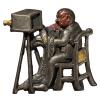
Suggest a Book that will Impress my Wife?
rkg replied to Randy's topic in General Nihonto Related Discussion
Clive, Actually I did reference it, just not by title :-) rkg -

Suggest a Book that will Impress my Wife?
rkg replied to Randy's topic in General Nihonto Related Discussion
Randy, I seem to be late to this, but here's some observations that are probably worth what you're paying for them :-) First, while a picture may be worth 1000 words, often a piece in hand is worth 1000 pictures. If you REALLY want the better half to get these, and depending on your situation, you might consider just taking her to one of the shows and letting her see the pieces in hand (remember the magnifying glass/flashlight, as often the showrooms aren't very well lit for viewing). Next, I've found time and again that pieces printed large often seem to get the uninitiated really interested - And, fwiw, this is also how you evaluate a piece in hand - pretty much everybody when studying a piece seriously eventually pulls out the magnifying glass, ends up holding the piece up close to their face, etc. you might see if you can find some of those old exhibition posters that show kodogu printed large... And finally, note that a lot of these books are shot in a hurry, often by people who don't really "get" kodogu, so often the images don't really show pieces in their best light (pun intended). All that said, the compton 100 pieces book would make a good coffee table book, the Met's recent book isn't bad (and is kind of bargain at the price you can get it for on Amazon these days), and if you want to spend more money and like the content you might look at the big goto book, or even Sasano's big silver book (if the wife does sculpture or is is into b/w images). Another option might be that Uchigatana Koshirae book printed by the Tokyo National museum a few years back (I really like how they take a koshirae apart and image all the pieces). If you just want some picture books for not much money, you might look at some of the softcover stuff coming out of Japan - museum exhibition catalogs, last year's DTI catalog, etc. As far as sword books go, if you're a beginner, I'd actually highly recommend picking up Paul Martin's translation of Nakahara's book (Facts and Fundamentals of Japanese Swords) sooner than later. there are a great many books that go into dizzying detail about smith/school genealogy, the minutae of how they signed their pieces, school characteristics and features and how they changed by week, yadda yadda, but very few address what actually makes a good piece (especially in English), and.. Beyond that, all the "usual suspects" are good (Harry's translations of the Nihonto Koza, Nagayama's book, etc). On collecting fittings, its a dark path :-) the only plus is that right now the world seems to be awash in reasonable "beginner" fittings for not all that much money - I can't believe how many "Jeez, that's cheap -I would have instantly bought that a few years ago" pieces I see available these days... That's the downside of getting to study the "good stuff" - after that its all you want to acquire... :-/ +1 on having a few good pieces rather than a safe full of mediocre ones though - that was probably the best advice I ever got on collecting... Good Luck, rkg (Richard George) -

New to Japanese swords on Ebay Auctions
rkg replied to Ten4bagua's topic in Auctions and Online Sales or Sellers
Hi, That piece was painfully fake - I'm glad you were able to get your money back. FWIW, if you're at all serious about this, I'd highly recommend finding a way to look at a number of real swords sooner than later. Reading books on the subject is fine, but you get a lot more out of it if you have seen some real pieces in hand so you kind of understand what the authors are talking about/what the pictures are actually showing you. There are a couple of sword shows in the next couple of months (notably the one in Minneapolis in a few weeks). I'd highly recommend going to one of these as soon as you can and just look at a bunch of swords (preferably with somebody along who can tell you what you are looking at/are supposed to be seeing) - they usually offer a handling etiquette class (go to that if you haven't handled these before, or get somebody to show you), and look at every piece you can that the vendors bring, attend the lectures, etc. I'd actually recommend not even bringing much spending money just so you don't buy immediately there - get a card and call the guy later after you've then gone back and studied your books for a while - and even if you miss the piece you had the hots for, remember that there will pretty much ALWAYS be another one (there are actually a goodly number of Japanese swords - while truly great pieces are few and far between, there's lots of "starter" pieces out there...). Good Luck, rkg (Richard George) P.S. ignore Robinson's discussion of tsuba care.. Please... -
Hey guys, What are the "right" materials to be using for lining tosogu boxes? What have you used with success? I had a moment and was looking (again) at making some custom tsuba box liners (even found somebody local to me who would do the little pillows and hand over a swatch of material for the box liner, etc), and it occurred to me that maybe some materials are "better" than others. Are there any fabrics that sometimes get used that should be avoided due to issues with outgassing, friability, tendency to hook/rip uttori off of pieces, tendency hold/attract moisture, etc? I've gotten a couple of boxes in the past with rust on the surface of the liners in the shape of features on a tsuba, and... Also, are there any preferred materials for the padding? I can probably figure it out from the MSDS (to check for outgassing or whatever), but if there's something you've used that works I'd like to hear about it... Thanks in advance, rkg (Richard George)
-

shipping a gendaito to England
rkg replied to rkg's topic in Sword Shows, Events, Community News and Legislation Issues
Clive/Peter, First, thank you very much for taking the time to reply! The guy who owns it figures he'll have to be paying VAT on it, so maybe that aspect isn't an issue. Also, what's the story with the date it "needs" to be - I'm asking because its a dated WWII piece - does the law specifically classify those differently? Also, do they know what "traditionally made" means, or does that need to be spelled out (made from tamagahane and water quenched), or...? On the harmonized tariff code, in the 2011 USITC site/documents 9705.00.00.90 is no longer listed as valid number (their "new"allowable suffixes for the last two digits are are 30, 60, 70, and 91 in the 9705 category),and I was trying to choose the closest replacement: http://www.usitc.gov/tata/hts/bychapter/index.htm ( go down to chapter 97 - great reading if you need to go to sleep or ship swords to foreign lands :-) ). Thanks, rkg (Richard George) -
Hi, I'm trying to ship a sword to somebody in England. As I haven't shipped a sword overseas in quite a while I need to know what the current "right" way to do this is. He wanted me to use fedex - are there any problems with using them at this time? Second, the piece is a gendaito, and I was wondering what the "correct" harmonized tariff code is to use with it. since its less than 100 years old, it would seem the typical one for an antique sword (9706.00.00.60) is incorrect - do you guys use the one for "generic" historical artifacts (9705.00.00.70), or...? And finally, since this is now a "controlled" item, is there any special declarations/paperwork/etc. needed on my part for this, or will the generic "Japanese fine art sword" declaration do, or...? Any input gratefully accepted. Thanks in advance, rkg (Richard George)
-
Guido, Though this is not that hot a photo of the piece, its actually not clear that its a "fake" (whatever that means with these). The piece actually generated a fair amount of discussion at the recent SF show (Haynes saw it there and thought it was genuine, though not one of the big 3, etc.). Best, rkg (Richard George)
-
for what purpose? Do you want a safe, a waterproof bag to carry a sword to the dojo, something to store them around the house in, or...? That said, You can check out Pelican cases - I have one of their longer ones and they're reasonably waterproof, pretty much indestructible, etc. But I haven't used it in a looong time, so... I think there are some other cheaper waterproof gun cases made now which would also work. You might also look at a golf bag case as well. Another option is to use ABS or PVC pipe and plumbing fittings - just put a clean out and cap on the ends of of a chunk of 3 or 4"abs or pvc tubing and you're good to go. I've seen some smallish soft cases that would work for just hauling a single sword around, but that was years ago and I don't have a suggestion for these - maybe you could also look at some of the "rafting bags" - it seems like some of these are pretty big these days, but YMMV on that. Best, rkg (Richard George)
-
Markus, I checked the US amazon.com site and it isn't up yet - do you know if it will get listed there as well? thx, rkg (Richard George)
-
-
one of my favorite pieces in my collection is one that your're not "supposed" to collect - its a fraction-of-an-inch-too-short-to-be-a-katana Wakizashi - Nambokucho period, pretty healthy/nice work and a kirikomi with a piece of the other guy's sword stuck in it - worse yet, it was papered to the netherworld of being Ko-uda piece... I'm sure you've all seen this, but... http://www.rkgphotos.com/recent_stuff/ko_uda.jpg now to go start setting up to shoot a nifty Naoe shizu tanto Best, rkg (Richard George)
-
For me lately its been mostly iron 'tea taste' tsuba - here's a few from my collection - probably my favorite of all time I is one I shot for somebody a year or three ago, but I can't post that, so... If this is tooo many, I can pull a few off...
-
Aside from their cool shape and the acres of hada they have to study/enjoy, naginata are interesting because they're difficult to make and really show off how good (or bad) a swordsmith is. I think these pieces with the sharpened back side were a late change for them so they could be used more like yari. Here's a couple I have that are made this way (sorry for the old pics - maybe I'll have time before too long to reshoot so they can be better appreciated - I still don't know about restoring the Fukuro one - it apparently was never mounted (or final polished), and I don't know whether to leave it as-is, have it fully polished, or just have one side polished) http://home.teleport.com/~rkg/photos/ku ... blade1.jpg http://home.teleport.com/~rkg/photos/ub ... verall.jpg Decent ones aren't that hard to find (you kind of have to ask around, as it seems most online sites don't put them up anymore (must have gotten tired of them sitting)), but here's a couple that aren't too bad :-) http://www.sanmei.com/contents/media/T1 ... _PUP_E.htm http://www.aoi-art.com/sword/sale/10568.html Best, rkg (Richard George)
-
Musical instrument makers - I picked up a pretty good sized bag of chips years ago from one of these guys... rkg (Richard George)
-
Hi, sorry to have neglected my own thread for so long, but life happens... :-/ First, I still don't know what to make of the seppa dai shape/nakago ana placement. I've seen a couple of other early pieces with "off" up placement, but in general one would think they should be centered There's an early partially finished hizen tsuba floating around that is roughed out but has a fairly carefully placed/finished nakago ana. On the other hand, I recently got an opportunity to study a fairly large number of over-the-top "tourist" tsubas, and none of them exhibited this (though quite a few exhibited work/inlays extending well into the seppa area, etc.). Its also been suggested it had something to do with the balance of the completed sword/tsuka combination. Its also a little confusing in that it looks like the piece has been re-mounted a couple of times at least (you can see subtle work in the nakago ana), and they keep using the same placement for whatever reason - or somebody went to a hell of a lot of work to replicate all the little tweaks. Second, on the finish. I've been told you do see showa pieces that exhibit the carefully manipulated surface features shown. But if you look at it closely the finish seems to exhibit an "age" to it that at least I hope nobody can replicate easily - if that's so we're screwed as collectors. One of the things I've been working on is testing how to display items in an e-book or app - I just got done with a test image of this piece. The file is pretty huge (10 megabytes), but you're welcome to look at it. Note that you can zoom in 2x on this, rotate it around, etc. Its at: http://www.rkgphotos.com/recent_stuff/t ... ktime.html If you zoom in and look at the patina, maybe you can see what I mean. Also, WRT the comparison of the two tsubas, someone I talked to pointed out that apparently people would take rubbings of tsuba they liked, which were then presented to a tsubako to be used for making a copy - and apparently they were seldom perfect copies as things would get lost in translation and be left up to the next guy to fill in the details. I mention this because it was suggested that perhaps one of them is a some number of copies removed copy of the other. Anyway, thanks again to all of those who have taken the time to post on this piece. Best, rkg (Richard George) P.S. I just realized I have an image of another "goofy"nakago ana placement: http://home.teleport.com/~rkg/photos/ts ... _small.JPG



